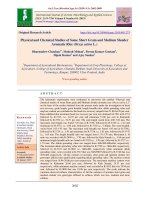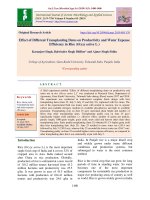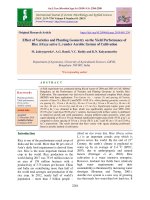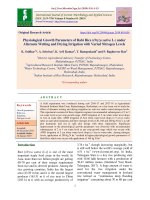Comparison of energy consumption for different sowing techniques and seed rate of direct seeded rice (Oryza sativa L.) under medium land situation of manipur
Bạn đang xem bản rút gọn của tài liệu. Xem và tải ngay bản đầy đủ của tài liệu tại đây (302.65 KB, 9 trang )
Int.J.Curr.Microbiol.App.Sci (2020) 9(3): 328-336
International Journal of Current Microbiology and Applied Sciences
ISSN: 2319-7706 Volume 9 Number 3 (2020)
Journal homepage:
Original Research Article
/>
Comparison of Energy Consumption for Different Sowing Techniques and
Seed Rate of Direct Seeded Rice (Oryza sativa L.) under Medium Land
Situation of Manipur
K. Nandini Dev1*, Herojit Singh Athokpam2, K. Khamba Singh3,
M. Anandi Devi3 and O. Gojendro Singh4
1
Department of Agronomy, College of Agriculture, Central Agricultural University, Imphal795004, Manipur (India)
2
Department of Soil Science and Agricultural Chemistry, College of Agriculture, Central
Agricultural University, Imphal-795004, Manipur (India)
3
Department of Biochemistry, 4Department of Zoology, Manipur College, Imphal-795008,
Manipur (India), India
*Corresponding author
ABSTRACT
Keywords
Direct seeded rice,
energy productivity,
seed rate, sowing
technique
Article Info
Accepted:
05 February 2020
Available Online:
10 March 2020
A field experiment involving two sowing techniques (broadcasting and line
sowing) and five different seed rates (80, 90, 100, 110 and 120 kg/ha) with
a total of ten treatments in factorial randomized block design with three
replications to compare the energy consumption for different sowing
techniques and seed rate of direct seeded rice (Oryza sativa L.) under
medium land situation of Manipur was conducted during kharif 2016 at
Research Farm of College of Agriculture, Central Agricultural University,
Imphal. The result revealed that highest total energy input was observed
from broadcasting of seed at the rate of 120 kg/ha (17790 MJ/ha) whereas
the lowest total energy input (17135 MJ/ha) from broadcasting of seed at
the rate of 80 kg/ha. In contrast highest output energy (217542 MJ/ha),
energy efficiency and highest energy productivity of grain (0.35) were
obtained from line sowing with seed rate 100 kg/ha. Energy intensity shows
that the highest energy consumption was from broadcasting of seed at the
rate of 120 kg/ha (3.44 MJ/ha) and the lowest from line sowing with seed
rate 100 kg/ha (2.90 MJ/ha).
transplanting, irrigation, application of
fertilizers,
agro-chemicals
for
plant
protection, harvesting, transportation etc. In
order to sustain agricultural production,
Introduction
Rice cultivation requires many
consuming operations such as
energy
tillage,
328
Int.J.Curr.Microbiol.App.Sci (2020) 9(3): 328-336
effective energy use is required, since it
provides
ultimate
financial
saving,
preservation of fossil resources and reduction
of environment distortion. The energy
consumption in the agricultural sector
depends to the population employed in the
agriculture, the amount of cultivable land and
the level of mechanization (Ozkan et al.,
2004). In the present era of energy crisis, for
formulating any policy on energy use and
conservation, it is imperative to examine the
pattern of energy consumption for agricultural
production especially rice.
related to crop production processes such as
land preparation, planting, crop management,
irrigation, harvesting, post-harvest operations
and transportation of agricultural inputs.
Energy that is used directly at farms and
fields are fuel, electricity and human energy.
On the other hand, indirect energy consists of
energy used for fertilizer, pesticides, seeds
and farm machinery. Paddy production is one
of the most energy intensive production
systems. As a result of increasing world crude
oil and fertilizer prices, input costs will
increase. The increase input costs will reduce
the use of inputs and paddy yields. On the
other hand, if there is excess input usage,
energy efficiency will also be reduced.
Since efficient use of the energy resources is
vital in terms of increasing production,
productivity, competitiveness of agriculture as
well as sustainability of rural living, energy
auditing is one of the most common
approaches to examining energy efficiency
and environmental impact of the production
system. It enables researchers to calculate output-input ratio, relevant indicators, and energy
use patterns in an agricultural activity (Adem
et al., 2006). When a natural system capable
of producing a certain amount of energy
containing biomass is converted into an agroecological system, the natural capability limit
is often exceeded by adding energy inputs.
The greater the input of external energy, the
more the natural capability of the system can
be exceeded, and the less sustainable the
system becomes. Because of this relationship,
an analysis of agro-ecosystem’s input/output
energy balance can be a comprehensive
indicator of its sustainability (Farshad and
Zinck, 2001). In this regard, efficient use of
energy by the agriculture sector seems as one
of the conditions for sustainable agriculture
because it allows financial savings, fossil
resources preservation and air pollution decrease (Pervanchon et al., 2002).
The aims of the study were to survey input
energy in rice production under two sowing
techniques and different seed rate, to
investigate the energy consumption and to
make an economic analysis of rice in
Manipur.
Materials and Methods
The experiment was consists of two sowing
techniques (Broadcasting and Line sowing)
with five seed rate (80 kg ha-1, 90 kg ha-1, 100
kg ha-1, 110 kg ha-1 and 120 kg ha-1) and
replicated thrice in factorial randomised block
design. The recommended dose of N:P:K was
60:40:30 kg ha-1. The fertilizers were used in
the form of urea, single super phosphate and
muriate of potash. Full dose of phosphorous
and potash along with half dose of urea were
applied uniformly as a basal to all the plots
three days before sowing. The remaining half
dose of nitrogen was applied in two equal
splits at active tillering stage (25 DAS) and
panicle initiation stages (65 DAS). The
experiment was carried out under rainfed
condition.
Energy requirement in agriculture are divided
into two groups – direct and indirect. Direct
energy is essential in performing various tasks
Energy equivalent inputs shown in Table 1
are used to calculate energy inputs and energy
329
Int.J.Curr.Microbiol.App.Sci (2020) 9(3): 328-336
outputs. Energy indices were calculated using
the following relationships (Sartori et al.,
2005).
energy. A similar finding of higher energy
input due to use of chemical fertilizer in rice
production was also reported by Khan et al.,
(2009).
Energy efficiency = [Output energy (MJ/ha)]/
Input energy (MJ/ha)
Direct and indirect energy
Energy productivity = [Grain yield (kg/ha)]/
Input energy (MJ/ha)
Table 4 shows the direct and indirect energy
consumption for different treatments in rice
production system. Among the treatments
maximum direct energy 4928 MJ/ha and 4924
MJ/ha were consumed in the treatment S2R5
and S1R5 respectively. Higher seed rate
require more human labour for cultivation
practices resulting to more direct energy. Line
sowing required more energy than the
broadcasting. Indirect energy consumption
was also observed in the same trend. The
highest indirect energy consumption (12862
MJ/ha) was observed from S1R5 and S2R5.
Energy Intensity = [Input energy (MJ/ha)]/
Grain yield (kg/ha)
Net energy gain = [Output energy (MJ/ha)] Input energy (MJ/ha)
Each agricultural input was divided into as
direct and indirect energy source. Direct
energy sources were labour energy, tractor
and/or other implement/machinery used for
the particular operation and electric/diesel
motor to run water pump, while indirect
energy sources included seed of high yielding
varieties, fertilizers and chemicals used in the
production process; energy sources were
classified into renewable and non-renewable.
Renewable energy included human, labour,
manure and seed, while non-renewable
sources included diesel, electricity, chemicals,
fertilizers, machinery.
Renewable energy and Non-renewable
energy
Renewable energy system in the rice
production was very low and showed that rice
production was based on non-renewable
resources that these sources cause the
environment pollution.
Total energy output
Results and Discussion
Highest output energy 217542 MJ/ha was
obtained from S2R3 followed by S2R4 (211553
MJ/ha). The lowest output energy (199054
MJ/ha) was observed from S1R1 that is
broadcasting of lower seed rate 80 kg/ha. This
shows that broadcasting with lower seed rate
produced less yield due to less plant
population per unit area. On the other hand
this observation could also be argued by the
statement that overusing of inputs caused
increment in consumed energy and lower
yield of rice. Similar finding was also
reported by Alipour et al., (2012). Higher
output energy can be obtained when 110 kg
Total energy inputs
The highest total energy input was observed
from S1R5 (17790 MJ/ha) and S2R5 (17786
MJ/ha) whereas the lowest total energy input
(17135 MJ/ha) and (17139 MJ/ha) recorded
from S1R1 and S2R1 respectively. The highest
in total energy input was due to higher seed
rate thereby needs more human labour for
harvesting and threshing. Among the energy
inputs
maximum
consumption
was
contributed by chemical energy followed by
mechanical energy and the lowest with human
330
Int.J.Curr.Microbiol.App.Sci (2020) 9(3): 328-336
seed/ha was sown in line because of more
grain yield per unit area.
system. This finding are in contrast with
Alipour et al., (2012) that rice energy ratio in
Guilan province of Iran was 2.19 lower than
6.7 rice energy ratio index estimated in
Australia by Khan et al., (2010).
Energy indices
Energy efficiency
Energy productivity
Figure 1 shows the energy efficiency of
different sowing technique with different seed
rate. According to rice, energy output and
energy expenditure, the highest energy
efficiency of rice production was observed
from S2R3 followed by S2R2. This shows a
better use of input energy in line sowing with
seed rate of 100 kg/ha and 90 kg/ha. The
lowest energy efficiency observed in S1R5
could be as a result of inefficient use of some
energy inputs due to inefficient irrigation
Energy productivity is the yield of marketable
product, that is, rice grain per unit of energy
consumed. The higher the value (>1), the
more energy efficient is the production
system. The highest energy productivity of
grain (0.35) was obtained from S2R3 and the
lowest (0.29) from S1R5. The lowest energy
productivity may be due to use of higher seed
rate i.e. 120 kg/ha.
Table.1 Energy equivalents for different inputs and outputs in rice
Items
Unit
Energy equivalent Reference
(MJ/unit)
L
56.31
Cherati et al., 2011
hr
2.31
Yaldiz et al., 1993
Nitrogen
kg
60.6
Esengun et al., 2007
Phosphate (P2O5)
kg
11.93
Esengun et al., 2007
Potassium (K2O)
kg
6.7
Esengun et al., 2007
Insecticide
kg
101.2
Yaldiz et al., 1993
Herbicide
kg
238
Pathak and binning, 1985
Fungicide
kg
216
Pathak and binning, 1985
kg
17
Singh and Mital, 1992
Paddy
kg
14.7
Moradi and Azarpour, 2011
Straw
kg
12.5
Moradi and Azarpour, 2011
Input
1. Fuel
Diesel
2. Human labour
3. Fertilizer
4. Pesticides
5. Seed
Output
331
Int.J.Curr.Microbiol.App.Sci (2020) 9(3): 328-336
Table.2 Energy inputs used in rice production system under different sowing
technique and seed rate
Treatment
S1R1
Mechanical
energy
(MJ/ha)
4730
Chemical
energy
(MJ/ha)
11002
Biological
energy
(MJ/ha)
1240
Human
energy
(MJ/ha)
162.68
Total energy
inputs
(MJ/ha)
17135
S1R2
4730
11002
1395
170.52
17298
S1R3
4730
11002
1550
178.36
17461
S1R4
4730
11002
1705
186.20
17624
S1R5
4730
11002
1860
194.04
17786
S2R1
4730
11002
1240
166.60
17139
S2R2
4730
11002
1395
174.44
17302
S2R3
4730
11002
1550
182.28
17465
S2R4
4730
11002
1705
190.12
17628
S2R5
4730
11002
1860
197.96
17790
S1 – Broadcasting; S2 – Line sowing; R1 - 80 kg ha-1, R2 - 90 kg ha-1, R3 - 100 kg ha-1, R4 - 110 kg ha-1 and
R5 -120 kg ha-1
Table.3 Different energy requirement for different treatment
Treatment
S1R1
Direct energy
(MJ/ha)
4893
Indirect energy
(MJ/ha)
12242
Renewable
energy (MJ/ha)
1403
Non-renewable
energy (MJ/ha)
15732
S1R2
4901
12397
1566
15732
S1R3
4908
12552
1728
15732
S1R4
4916
12707
1891
15732
S1R5
4924
12862
2054
15732
S2R1
4897
12242
1407
15732
S2R2
4904
12397
1569
15732
S2R3
4912
12552
1732
15732
S2R4
4920
12707
1895
15732
S2R5
4928
12862
2058
15732
S1 – Broadcasting; S2 – Line sowing; R1 - 80 kg ha-1, R2 - 90 kg ha-1, R3 - 100 kg ha-1, R4 - 110 kg ha-1 and
R5 -120 kg ha-1
332
Int.J.Curr.Microbiol.App.Sci (2020) 9(3): 328-336
Table.4 Energy output obtained in rice production system under different sowing technique and
seed rate
Treatment
S1R1
Grain yield
(kg ha-1)
5208
By-product
(kg ha-1)
9466
Total energy output
(MJ ha-1)
199054
S1R2
5639
9597
207361
S1R3
5706
9733
210108
S1R4
5436
9633
204677
S1R5
5164
9667
200874
S2R1
5578
9633
206870
S2R2
5706
9700
209695
S2R3
6030
9926
217542
S2R4
5695
9863
211553
S2R5
5406
9889
207403
S1 – Broadcasting; S2 – Line sowing; R1 - 80 kg ha-1, R2 - 90 kg ha-1, R3 - 100 kg ha-1, R4
- 110 kg ha-1 and R5 -120 kg ha-1
Fig 1 (a) Energy Efficiency
333
Int.J.Curr.Microbiol.App.Sci (2020) 9(3): 328-336
(b) Energy productivity
(c) Energy Intensity
334
Int.J.Curr.Microbiol.App.Sci (2020) 9(3): 328-336
(d) Net energy gain
investigation it can be concluded that highest
energy output, energy efficiency and highest
energy productivity of grain were obtained
from line sowing with seed rate 100 kg/ha.
Energy intensity
Energy intensity is an index which shows how
much energy was used to produce one unit of
disposable/ marketable yield (rice grain). The
lower the index the more efficient is the use
of energy in the production system. Energy
intensity shows that the highest energy
consumption was for S1R5 (3.44 MJ/ha) and
the lowest for S2R3 (2.90 MJ/ha). Figure 1 (c)
shows that about 3.44 MJ/ha of energy is
required to produce only a kilogram of paddy
in the treatment S1R5. This implies that there
was low grain output in respect to energy
inputs used in the production process due to
inefficient energy inputs used. The highest net
energy gain (200.08 GJ/ha) was from S2R3
and the lowest (181.92 GJ/ha) from S1R1.
Acknowledgement
Authors are thankful to the Dean, College of
Agriculture, Central Agricultural University,
Imphal for all the financial and technical
support to carry out this research.
References
Adem Hatirli, S., Ozkan, B. and Fert, C.
(2006). Energy inputs and crop yield
relationship in greenhouse tomato
production. Renewable Energy 31: 427–
438.
Alipour, A., Veisi, H., Darijani, F.,
Mirbagherim B, and Behbahani, A.G.
(2012). Study and determination of
energy consumption to produce
conventional rice of the Guilan
province. Res. Agr. Eng. 58(3):99-106.
In conclusion, a quantitative energy inputoutput analysis of rice production was studied
based on the level of energy consumption,
forms of energy and some energy indices such
as energy ratio, specific energy, energy
productivity and net energy. From the above
335
Int.J.Curr.Microbiol.App.Sci (2020) 9(3): 328-336
Cherati, F.E., Bahrami, H. and Asakereh, A.
(2011). Energy survey of mechanized
and traditional rice production system in
Mazandaran Province of Iran. Afr. J.
Agric. Res. 6(11): 2565-2570.
Esengun, K., Gunduz, O. and Erdal, G.
(2007). Input-output energy analysis in
dry apricot production of Turkey.
Energy. Conver. Manage. 48: 592-598.
Farshad, A., Zinck, J.A. (2001). Assessing
Agricultural Sustainability Using the
Six-Pillar Model: Iran as a Case Study.
In: Gliessman S.R., Agroecosystem
Sustainability: Developing Practical
Strategies. Boca Raton, CRC Press:
137–152.
Khan, M.A., Awan, I.U. and Zafar, J. (2009).
Energy requirement and economic
analysis of rice production in western
part of Pakistan. Soil and Environment
28(1), 60-67.
Khan, S., Khan, M.A., Latif, N. (2010).
Energy Requirements and Economic
Analysis of Wheat, Rice and Barley
Production in Australia. J. Soil Environ.
29(1): 61-68.
Moradi, M. and Azarpour, E. (2011). Study of
energy indices for native and breed rice
varieties production in Iran. World
Appl. Sci. J., 13(1): 137-141.0.
Ozkan, B., Akcaoz, H. and Karadeniz, F.
(2004). Energy requirement and
economic analysis of citrus production
in Turkey. Energy Conver. Manage. 45:
1821-1830.
Pathak, B. and Binning, A. (1985). Energy
use pattern and potential for energy
saving in rice-wheat cultivation. Agric.
Energy, 4: 271-280.
Pervanchon, F., Bockstaller, C. and Girardinc,
P. (2002). Assessment of energy use in
arable farming systems by means of an
agro-ecological indicator: the energy
indicator. Agricultural Systems, 72:
149–172.
Sartori, L., Basso, B., Bertocco, M. and
Oliviero, G. (2005). Energy use and
economic evaluation of a three year
crop rotation for conservation and
organic farming in NE Italy. Biosyst.
Eng., 9(2): 245-250.
Singh, S. and Mital, J.P. (1992). Energy in
Production Agriculture. Mittal Pub,
New Delhi.
Sinha, S.K. and Talati, J. (2007). Productivity
impacts of the system of rice
intensification (SRI): A case study in
West Bengal, India. Agr. Water Manag.
87: 55-60.
Yaldiz, O., Ozturk, H.H., Zeren, Y. and
Bascetincelik, A. (1993). Energy Usage
in Production of Field Crops in Turkey.
In: Vth International Congress on
Mechanization
and
Energy
in
Agriculture. Izmir- Turkey 527-536 pp
How to cite this article:
Nandini Dev, K., Herojit Singh Athokpam, K. Khamba Singh, M. Anandi Devi and Gojendro
Singh, O. 2020. Comparison of Energy Consumption for Different Sowing Techniques and
Seed Rate of Direct Seeded Rice (Oryza sativa L.) under Medium Land Situation of Manipur.
Int.J.Curr.Microbiol.App.Sci. 9(03): 328-336. doi: />
336









